In the past, I have used many different starting positions with my dogs. Most recently before this weekend, I simply put the dog between my legs, bent over to hold onto their collar, then let go when the time was right.
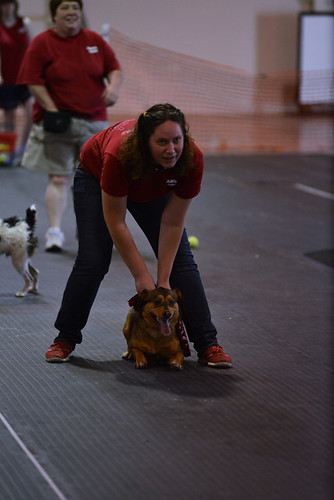 |
| Releasing Pallo for a pass |
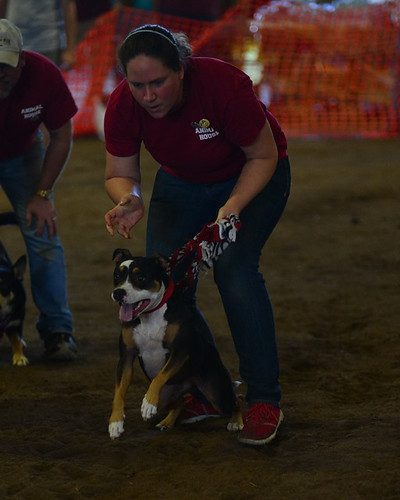 |
| Releasing Koira in start |
While this method actually works really well with Pallo, it kind of fails with Koira. Koira gets very excited and barks up into my face, while Pallo hunches down and stares down the lane. The looking up ends up making Koira really unreliable when starting with this method, which I learned after the X-Fidos tournament.
This past weekend, I tried out a new method.
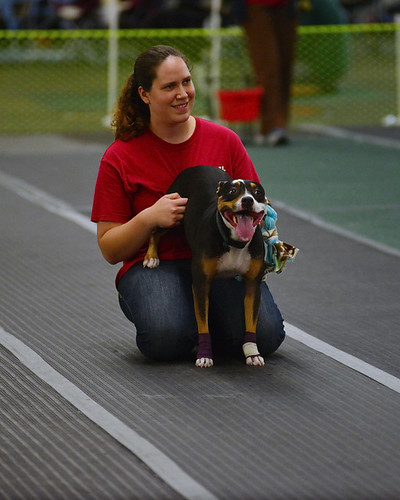 |
| Releasing Koira in start from my lap |
Instead of standing over Koira, I am kneeling and pulling her back legs up onto my thighs. This gives her a solid launch platform and seems to focus her attention forward down the lane rather than back or up at me. I actually settled on this release method after trying three different ones and having people watch Koira launch from each of them. Then we decided which one she looked the most balanced during, which ended up being the one you see above- her front legs on the ground, back feet up on my thighs, and me holding onto her hips.
It might not mean a whole lot to you if you don't play flyball, but I'll say it anyway. Changing out starting position like this caused Koira to be much faster (good push off) and more consistent (no waiting for her front feet to hit the ground). So much so, in fact, that we had to back up 6+ feet to start this past weekend versus the weekend before.
Of course, after spending a lot of time thinking about starting and releasing positions and methods these past few weeks, I ended up getting quite a few pictures of other peoples' starting techniques.
Down on one knee seemed very popular. I actually tried a down-on-one-knee method for Koira, but didn't like it as much for us. From the pictures, though, many people obviously really like this method.
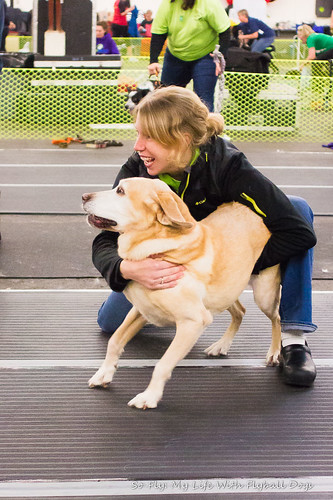 |
| Down on one knee, dog pulled back against other leg, with back foot perpendicular to the racing lanes. This is the closest I have to a picture of the one-knee method I tested with Koira |
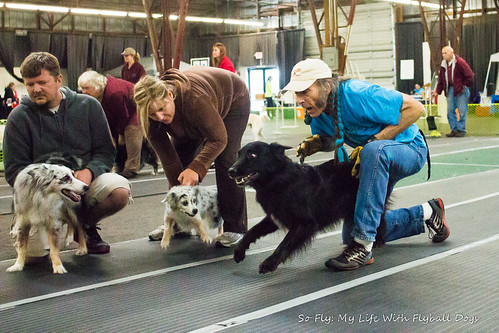 |
| Down on one knee, with the dog pulled back against the leg with the knee down. |
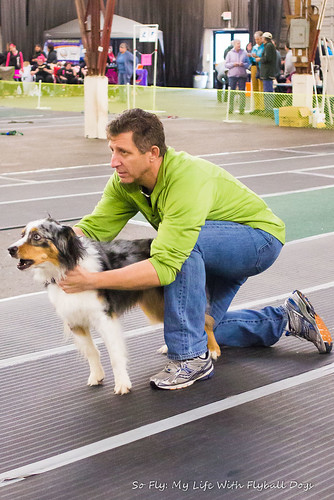 |
| One knee position, dog loaded back against the leg with the knee down, kept in place facing forward by the other knee |
Then, there is this two-knee method. It appears different from the method I use, because the dog is pulled back between the knees with the back feet still on the ground, where as I pull Koira's back feet up onto my thighs.
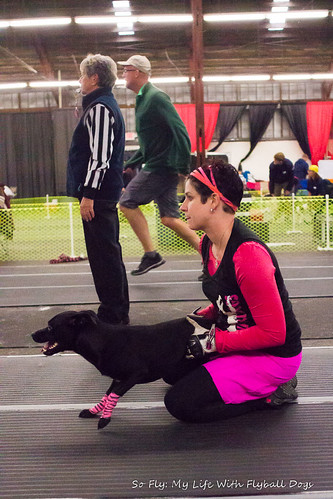 |
| Both knees down, dog loaded between the legs with back feet still on the ground |
There are also a number of ways to start your dog while staying standing. I will say that these tend to be easiest on the handler, because you don't have to get up quickly from these. If you have a short dog, though, your back can get sore from leaning over so much.
The first of the standing positions is more of a crouch. The knee isn't actually on the ground, but is certainly bent.
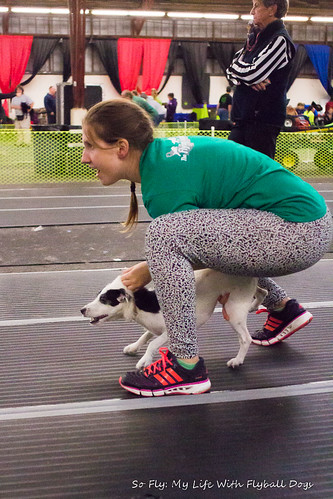 |
| Somewhere between a one-knee method and a standing method, this crouch is none-the-less quite effective for this team |
And then same thing here, only with the legs a bit straighter. Also, this whippet appears to be pulled back against the leg that is farther back, to give a better launching platform.
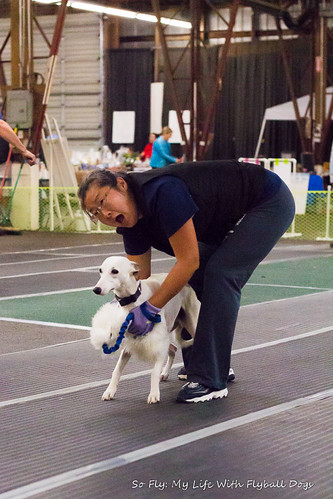 |
| This whippet is obviously very forward focused, and you can see how it is crouching down a bit, anticipating being released to run. |
The straddle method is very popular as well.
 |
| Lacey, the dog here, is super mellow while waiting, but runs really well once released. All her handler has to do is let her hands drop away from Lacey |
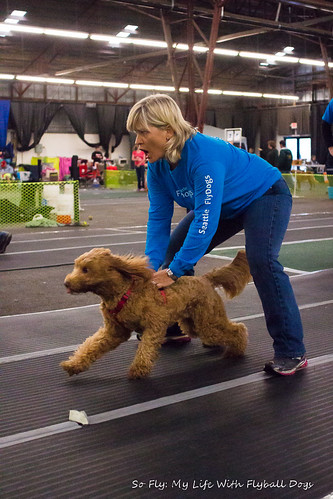 |
| And this dog is obviously incredibly excited and raring to go. |
Last but not least is the side release standing position, with the dog fully off to one side of the handler.
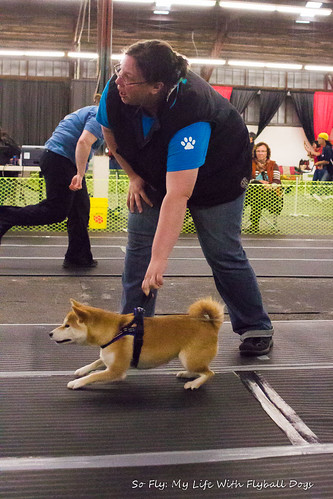 |
| This little shiba was also very obvious about wanting her turn as well. |
All of these positions can work great depending on the specific dog/handler team. I'm also positive that there are plenty of other release methods that I didn't get a picture of! Some dogs need a really steady launch platform on or against their handler, while others crouch down to the ground or simply dig into the ground with their feet. While there might be a right way for a certain dog and a certain handler, there is definitely not a right way for all dogs and handlers. If you are struggling with how to release your dog, get a training buddy and practice. Try out the different methods while just doing recalls with your dog and see which ones feel the best for you and look the most balanced for your dog. As I found out this past weekend, it can make a huge difference in how your dog runs if you find the right release.
You forgot to mention the bruises that are a result of the lap release method. :)
ReplyDeleteI release Cohen down on one knee, but I want to graduate her to the method you're currently using with Koira. We're still working out the kinks. When I run one of our team's height dogs I'm black and blue afterwards due to the lap release. For a week afterwards it looks like I've been brutally beaten. Ah flyball! :)
Great photos! So true there are tons of different method. It took the better part of a season to find the method that worked best for Sophie. We do the half crouch while holding her around the middle. But usually by sunday evening my back is stiff from that position and her bucking bronco antics that we switch to a straddle which isn't always as effective since she usually rears up and hits me in the nose :-P
ReplyDeleteI've been practicing similar releases for Elli for no particular reason. There isn't any flyball in MT, so... that's lame.
ReplyDeleteI straddle and hold her hips, waiting for her to pull against me, then my helper throws the ball and I release at the same time. Typically I use this if I don't want to kneel in mud.
I'm also a fan of the lap-release method. I've found that if you've got strong thigh muscles, bruising doesn't happen as easily. :) Typically, she is running about 40yards in 4.5s. :)
Looks like the dogs are more than ready to catch those balls. I love some of the dogs' expressions. I sometimes throw a ball for Charlie the miniature schnauzer and have to hold Beamer back or else he'd push Charlie out of the way to get the ball. I usually just make him sit and hold his collar and that's enough to let him know to wait.
ReplyDeleteLooks like the dogs are more than ready to catch those balls. I love some of the dogs' expressions. I sometimes throw a ball for Charlie the miniature schnauzer and have to hold Beamer back or else he'd push Charlie out of the way to get the ball. I usually just make him sit and hold his collar and that's enough to let him know to wait.
ReplyDeleteThat's cool! I never thought about it before:) Koira looks pretty axcited!
ReplyDeleteThis was really interesting to read, and I don't play flyball. Like with just about anything, so much more goes into it than meets the eye!
ReplyDeleteFun to see all of the different methods compared and analyzed like that!
ReplyDeleteDefinitely bruises with the lap method!!! Pan always leaves me plenty. If starting with Pan I hold her by the hips, but if i'm passing I hold Pan by the collar when she's on my lap.. she's too excited to go and I can't hold her back by just her hips, especially if we're running third.
ReplyDeleteTrophy started rearing back on his own to launch. I started with the standing straddle, but as he got excited he would naturally rear up and then explode/bounce forward. I made him a harness to help him with this. I don't pull him up, he does it on his own and when I let go he's actually pretty consistent with his starts using this method - but he's also focused down the lane and not backwards on me.
With Demo we do a squatting hip grab, using your butt to counter balance as he's such a maniac.
I don't do flyball but I love this post! So interesting to see all the different methods!
ReplyDeleteReally interesting. To be honest - I would think your method gives Koira a leg up (no pun intended) but because she has such a good launch position - like a cannon - by pushing off your lap - no?
ReplyDeleteThat is interesting to see all the methods for releasing. I'd imagine the one you've settled on for Koira to be very effective. Good luck with it!
ReplyDelete